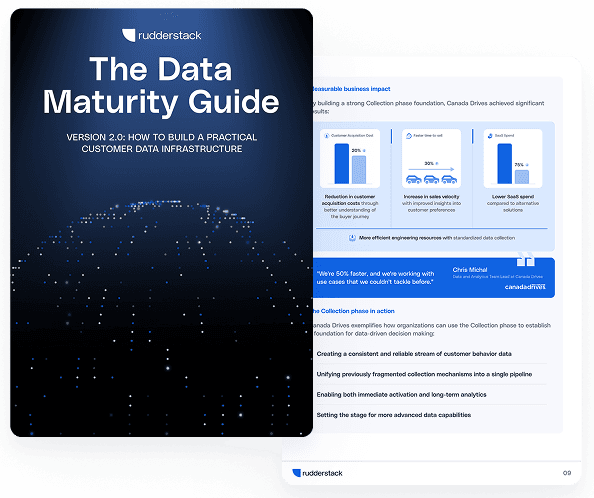Generative AI risks and how to approach LLM risk management

What if your AI tool started making things up, leaking secrets, or exposing your business to new threats? Generative AI risks are different from anything we’ve faced with traditional software or analytics.
When you connect these powerful models to your systems, the stakes get much higher. Record levels of private investment in AI highlight the need for robust risk management. Understanding generative AI risks is the first step to using this technology safely and confidently.
In this post, we'll explore the key risks associated with large language models (LLMs), including hallucinations, data leakage, prompt injection, and compliance gaps. We'll walk through concrete strategies for detecting and mitigating these risks across infrastructure, data, and governance layers. You'll also learn how RudderStack helps reduce LLM risk by giving teams full control over data flows, enforcing privacy policies, and maintaining end-to-end observability from ingestion to activation.
Main takeaways:
- Generative AI introduces new risk categories, including hallucinations, data leakage, and prompt injection, that traditional AI systems don't typically encounter
- The black-box nature and scale of LLMs make explainability and observability critical for managing output reliability and model behavior
- Security risks escalate when generative models are integrated with real-time systems, requiring robust API controls, access permissions, and audit logging
- Compliance and IP risks arise from unclear content ownership and training data provenance, making documentation and regulatory alignment essential
- RudderStack helps mitigate generative AI risks by giving data teams full control over data pipelines, enforcing governance policies, and maintaining end-to-end visibility across LLM deployments
What new challenges do LLMs pose?
In 2023, 55% of executive leaders reported to Gartner that they are in piloting or production mode with generative AI, showing how many businesses are investing time and resources into AI. But it's not without its own challenges.
Generative AI creates new text, images, or code that can appear accurate but may contain errors, bias, or security flaws. These models learn from massive datasets and produce outputs that aren't always predictable or verifiable.
Unlike traditional AI, which classifies or predicts, generative AI synthesizes new content based on probability. This fundamental difference creates unique generative AI risks for data teams and enterprises.
- Scale complexity: Models with billions of parameters create more potential failure points
- Black box nature: Limited visibility into why an LLM produced specific output
- Rapid evolution: Frequent updates introduce new risks or behavioral changes
- Integration risks: Connecting LLMs to business systems exposes sensitive data
The dangers of generative AI stem from their ability to create convincing but potentially flawed outputs at scale. When these systems connect to your critical infrastructure, the risk profile changes dramatically.
For example, in 2023, OpenAI temporarily disabled ChatGPT's history feature after a user discovered the tool was exposing snippets from other users' prior chats. Incidents like this underscore how memorization, hallucination, or unintended prompts can surface sensitive data or cause reputational harm, especially in production environments.
Even seemingly benign integrations, like customer support bots or marketing content generators, can go off-script and violate brand, legal, or security standards if output validation isn't enforced. These risks increase as LLMs are paired with real-time data or allowed to trigger actions autonomously.
✅ How RudderStack helps
RudderStack gives you full control over what data reaches generative AI systems and what leaves. With consent-aware pipelines, real-time filtering, and detailed audit logs, you can enforce input/output governance and stop risky data before it reaches your model or users.
Generative AI vs. traditional AI
Traditional AI models classify data or make predictions within constrained parameters. Generative AI creates entirely new content with fewer boundaries.
This difference matters for your risk assessment. Traditional models have well-understood failure modes, while generative models introduce new concepts like hallucinations, prompt injection, and model poisoning. Recent research shows that poisoning as little as 0.1% of the dataset used by an AI model can lead to successful targeted manipulation.
| Risk category | Traditional AI | Generative AI |
|---|---|---|
Data security | Focus on input data | Concerns with both input and output |
Accuracy | Clear metrics | Subjective and context-dependent |
Compliance | Established frameworks | Rapidly evolving regulations |
Bias | Detectable through testing | Subtle, context-driven |
GenAI risks often appear subtler but can have a greater impact. For example, a model might inadvertently leak proprietary formulas, customer PII, or strategic plans it encountered during training, creating serious GDPR, HIPAA, or CCPA compliance violations.
These exposures can occur months after deployment and without obvious error signals, making them particularly dangerous for regulated industries like healthcare and finance, where penalties can reach millions of dollars per incident.
Key risks of generative AI and how to manage them
Generative AI introduces new failure modes that traditional risk frameworks weren't designed to handle. This section breaks down the most critical LLM risk categories and offers practical strategies for mitigation across data, infrastructure, and governance layers.
Hallucination and factual inaccuracy
LLMs can produce content that appears confident and credible but is factually incorrect—what the industry commonly refers to as hallucinations. These hallucinations often blend real information with invented claims, resulting in misleading outputs that are difficult to detect at a glance.
The consequences vary by domain: a hallucinated revenue forecast in a business report can misguide leadership decisions, while an AI-generated legal argument citing fabricated case law can result in real-world liability. In healthcare, fictitious medical protocols could compromise patient safety and expose organizations to regulatory penalties.
How to manage it:
- Infrastructure layer: Deploy human-in-the-loop workflows for high-stakes outputs and enforce minimum model confidence thresholds before surfacing results.
- Data layer: Integrate retrieval-augmented generation (RAG) techniques to ground LLM responses in verified databases, APIs, or document repositories.
- Governance layer: Establish approval workflows for publishing or acting on LLM outputs in regulated domains and implement hallucination monitoring dashboards.
Key strategies:
- Use statistical outlier detection to flag improbable claims
- Implement source citation verification and contradicting statement detection
- Employ model ensemble voting or consensus to reduce single-model misfires
Bias and ethical concerns
Generative models are trained on large datasets scraped from the internet and other unvetted sources—many of which contain biased, stereotypical, or exclusionary language. As a result, even the most advanced LLMs can propagate gender, racial, cultural, or socioeconomic bias in subtle and overt ways.
This presents both ethical and operational risks. Biased outputs may alienate customers, erode trust, and in some regions (e.g., the EU or California), open the door to regulatory consequences under discrimination laws.
How to manage it:
- Infrastructure layer: Enable model reproducibility and logging to investigate flagged outputs and replicate bias conditions during review.
- Data layer: Audit datasets for demographic diversity and integrate debiasing tools during preprocessing.
- Governance layer: Conduct red-teaming simulations, solicit diverse stakeholder review, and document known risks with impact assessments.
Examples of best practices:
- Run large-scale prompt evaluations across demographic identifiers
- Include fairness metrics in your model evaluation criteria
- Provide public documentation on model limitations and failure cases
Research from Stanford's Human-Centered AI Institute shows that even the most advanced LLMs can perpetuate harmful stereotypes.
Data leakage and sensitive information exposure
A particularly dangerous failure mode occurs when LLMs memorize and reproduce sensitive or private information from training data—such as names, email addresses, financial records, or internal documents. In some benchmark tests, models have been shown to reproduce sensitive strings from open-source code repositories or unredacted chat logs.
This risk is exacerbated in industries subject to data privacy regulations like HIPAA, GDPR, or PCI DSS, where even a single exposure can carry steep fines or operational setbacks.
How to manage it:
- Infrastructure layer: Encrypt data in transit and at rest, enforce zero-trust access controls, and isolate training environments.
- Data layer: Apply automated PII detection and redaction before model ingestion and perform memorization testing post-training.
- Governance layer: Create clear policies around consent, data lineage, and retention, and maintain audit logs for sensitive output review.
Tools to implement:
- Differential privacy training techniques
- Canary strings to test for memorization
- Domain-specific NER systems to catch edge-case PII
Security risks of generative AI in real-time systems
Real-time AI integrations—such as chatbots, virtual assistants, or auto-generated emails—introduce a new class of attack surfaces. Threats include prompt injection (where an attacker crafts input to override instructions), model boundary probing, API abuse, and adversarial attacks designed to elicit unintended responses.
According to research on black-box attacks, many adversarial queries can succeed with surprisingly few attempts—making stealthy manipulation possible even in restricted environments. When AI is used to drive customer-facing or automated decisions in real time, even small vulnerabilities can scale rapidly.
How to manage it:
- Infrastructure layer: Use strong API authentication, rate limiting, and network segmentation between AI systems and core infrastructure.
- Data layer: Sanitize inputs, validate prompts against known attack patterns, and restrict context windows for session-bound use.
- Governance layer: Log every model interaction, monitor for outliers, and build escalation paths for anomaly resolution.
Mitigation practices:
- Create isolated execution environments for model queries
- Enforce RBAC (role-based access control) for prompt submissions
- Use adversarial red-teaming frameworks to simulate attack attempts
Ready to build a secure foundation for AI? Request a demo to see how RudderStack empowers your team to control data risks from day one.
Legal, compliance, and IP risks
LLMs trained on open internet data may inadvertently reproduce or remix copyrighted material—potentially leading to legal disputes around ownership, fair use, or unauthorized reproduction. If your model generates marketing copy that resembles protected content, or code that mirrors open-source libraries without licensing, you may be at risk.
Recent lawsuits have challenged whether AI-generated content can be copyrighted and what obligations apply to training data transparency. Emerging frameworks like the EU AI Act and NIST RMF are beginning to formalize obligations in this space.
How to manage it:
- Infrastructure layer: Version and log all training and output models, including associated datasets.
- Data layer: Classify datasets by license type and avoid training on high-risk data without proper clearance.
- Governance layer: Maintain model cards, create attribution logs, and label AI-generated content per compliance requirements.
Additional steps:
- Include content attribution tags in metadata
- Publish model documentation with training data summaries
- Establish legal review checkpoints for commercial deployments
Model drift and explainability gaps
Generative models can change behavior after fine-tuning, exposure to new data, or internal architecture adjustments. Without strong observability, these changes go unnoticed—resulting in drift that degrades performance, introduces new risks, or causes inconsistencies across environments.
Compounding this issue is the lack of transparency in LLM decision-making. Teams often struggle to explain why a particular output was generated or which features drove a model's response—making troubleshooting and audit readiness difficult.
How to manage it:
- Infrastructure layer: Implement canary releases, regression testing, and shadow deployment before rolling out model updates broadly.
- Data layer: Maintain stable benchmark datasets and track model accuracy and completeness over time.
- Governance layer: Use explainability tools like LIME, SHAP, and saliency maps to make decision logic interpretable and support root cause analysis.
Controls to prioritize:
- Regular drift testing with known input-output pairs
- Use of embedding comparison to detect semantic drift
- Re-training governance with rollback options
- Explainability documentation integrated into model cards
Govern and scale generative AI safely with RudderStack
Strong data governance is essential when deploying generative AI. You need control over how data flows to models, how it's stored, and how it's monitored.
RudderStack's cloud-native customer data infrastructure helps teams that need both innovation and compliance. You can unify event data, apply transformation rules before data reaches AI systems, and enforce consent policies automatically.
With RudderStack, your data remains in your environment unless you specify otherwise. This approach reduces gen AI security risks and supports zero-trust security architectures.
Real-time schema validation and comprehensive audit logs help you catch issues early and maintain compliance records. This foundation lets you operationalize generative AI while maintaining full data control.
RudderStack's customer data infrastructure provides the technical foundation you need to implement generative AI responsibly. With full data control and built-in governance features, you can move quickly while managing risks effectively.
Request a demo to see how RudderStack can help you build safer, more reliable AI-powered systems.
FAQs about generative AI
What are the problems with generative AI?
Generative AI can produce inaccurate or biased content, leak sensitive information, and act unpredictably due to its black-box nature. These risks increase when models are connected to real-time systems or exposed to unfiltered data.
Are there downsides of generative AI?
A major downside is hallucination; when the model confidently generates plausible but false or misleading outputs, it can undermine trust and decision-making.
What are the primary risks associated with generative AI models?
Primary risks include the hallucinations mentioned above, privacy violations, security vulnerabilities, bias in outputs, and compliance gaps. Managing these requires robust governance, monitoring, and data control mechanisms.
Published:
August 21, 2025








